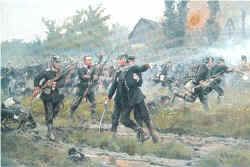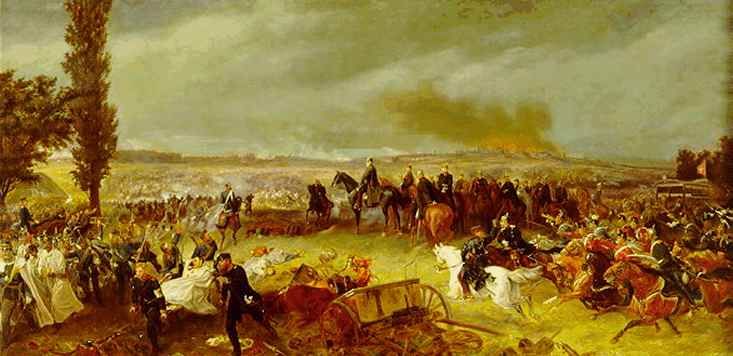The First major battle in the south begins. In the plains about 50 miles south of Frankfurt, the Prussian IV Corps comes into contact with elements of the 1st Bavarian Army. The Bavarians decided to make a retreat so that their French and Austrian comrades can come and help. The two armies meet each other at about 3 PM. The Prussians, with about 20,000 men against the 75,000 Allies, put up stoic resistance, holding out until night comes and the firing stops, for the most part.

Bavarian Infantry charging out of the woods.
August 10, 1870
Battle resumes on the fields of Frankfurt at around 5 AM. Prussian Jägers make a name for themselves by picking off infantry officers as they lead their troops into battle. However, no amount of sharpshooters can turn the tide of the Allies, and the IV Corps retreats after about four hours of fighting and 9,000 dead. The Allies on the other hand, suffer a moderate 5,000 dead. The French bear the brunt of the casualties, so the French 3rd Division of IV Corps is brought in to replenish losses.
Von Moltke sees what the Allies are trying to do. By holding the French border and allowing the south to be the main line of offense, the French can cut off the Prussian Army’s supplies. He desperately drafts orders for more men to join IV Corps in halting the Allied advance.
August 12, 1870
In Dresden, King John I of Saxony declares War on Prussia and the North German Confederation. In Berlin Otto von Bismarck flies into a rage. “Only with the full weight of Germany behind us,” he says, “Can we triumph!”
On this same day, Archduke Albert finally begins his attack into Prussian Silesia. The Army of Bohemia consists of more than 115,000 men and was still growing when it began marching. The Prussians have been expecting this for some time and Albert will be met with strong defensive positions.
August 14, 1870
Elements of the Army of Tyrol reach the outskirts of Wiesbaden on the Rhine.
August 16, 1870
Prussia launches a counterattack against the Allied Army in Wiesbaden. The Prussian Third Army, consisting of roughly 90,000 men face off against the combined Prussian, Austrian, and Bavarian armies, totaling 95,000 men.
From the start the battle is a disaster for the Allies. Marshal MacMahon is away in Metz conferring with Emperor Napoleon III and therefore the command is passed to the inexperienced Marshal François Canrobert. Also, the Prussians intentionally attack only the Bavarians, who are generally soldiers of a poorer-quality than the French or even Austrians.
The Prussians, on the other hand, are led by the extremely bright Crown Prince Friedrich, they enjoy a standard of training better than any in Europe, and, for the most part, superior technology.
The Battle is the largest of the war, to date. The blistering hot August sun makes fighting no less difficult. Within two hours of fighting the Bavarians break, leaving the entire right flank of the Allied position vulnerable. Friedrich immediately sends in the brilliant-looking Prussian Cruassiers to wreak havoc in the Allied rear. Needless to say, the cavalry are very much successful in this endeavor, and the entire Allied army is forced to retreat with as much haste as possible.
It is a complete and utter defeat for the Allies, as they are pushed from the Rhine.

Cruassiers charging the Guns at Wiesbaden
To Be Continued….
Battle resumes on the fields of Frankfurt at around 5 AM. Prussian Jägers make a name for themselves by picking off infantry officers as they lead their troops into battle. However, no amount of sharpshooters can turn the tide of the Allies, and the IV Corps retreats after about four hours of fighting and 9,000 dead. The Allies on the other hand, suffer a moderate 5,000 dead. The French bear the brunt of the casualties, so the French 3rd Division of IV Corps is brought in to replenish losses.
Von Moltke sees what the Allies are trying to do. By holding the French border and allowing the south to be the main line of offense, the French can cut off the Prussian Army’s supplies. He desperately drafts orders for more men to join IV Corps in halting the Allied advance.
August 12, 1870
In Dresden, King John I of Saxony declares War on Prussia and the North German Confederation. In Berlin Otto von Bismarck flies into a rage. “Only with the full weight of Germany behind us,” he says, “Can we triumph!”
On this same day, Archduke Albert finally begins his attack into Prussian Silesia. The Army of Bohemia consists of more than 115,000 men and was still growing when it began marching. The Prussians have been expecting this for some time and Albert will be met with strong defensive positions.
August 14, 1870
Elements of the Army of Tyrol reach the outskirts of Wiesbaden on the Rhine.
August 16, 1870
Prussia launches a counterattack against the Allied Army in Wiesbaden. The Prussian Third Army, consisting of roughly 90,000 men face off against the combined Prussian, Austrian, and Bavarian armies, totaling 95,000 men.
From the start the battle is a disaster for the Allies. Marshal MacMahon is away in Metz conferring with Emperor Napoleon III and therefore the command is passed to the inexperienced Marshal François Canrobert. Also, the Prussians intentionally attack only the Bavarians, who are generally soldiers of a poorer-quality than the French or even Austrians.
The Prussians, on the other hand, are led by the extremely bright Crown Prince Friedrich, they enjoy a standard of training better than any in Europe, and, for the most part, superior technology.
The Battle is the largest of the war, to date. The blistering hot August sun makes fighting no less difficult. Within two hours of fighting the Bavarians break, leaving the entire right flank of the Allied position vulnerable. Friedrich immediately sends in the brilliant-looking Prussian Cruassiers to wreak havoc in the Allied rear. Needless to say, the cavalry are very much successful in this endeavor, and the entire Allied army is forced to retreat with as much haste as possible.
It is a complete and utter defeat for the Allies, as they are pushed from the Rhine.

Cruassiers charging the Guns at Wiesbaden
August 30, 1870
In the face of very strong Prussian defenses, the Austrian offensive is halted after only gaining a few miles inside of Prussia. Franz Josef is furious, but soon calms down after Albert sends word of his new battle plan.
The Prussians, meanwhile, use this lapse in action as precious time to strengthen their fortifications. This formidable line of forts and bunkers is being called the "Bismarck Line" by the press.

One of the strongpoints in the Bismarck Line
September 5, 1870
The Allied army in the south, having a good three weeks of rest, once again is on the march. The force has been reinforced with two Austrian corps, and a division of Saxons. The Saxon force is especially needed, for most of the men in it fought against von Moltke and the Prussians in 1866, and are very good soldiers.
The Allies are making very good progress on the first day, gaining almost 10 miles before nightfall.
September 8, 1870
The Allies reach Wiesbaden for the second time. Greeting them are Prussian soldiers of the Third Army. It seems that the Second battle for Wiesbaden is about to be fought.
September 9, 1870
125,000 Allies meet 100,000 Prussians on the plains near Wiesbaden. Crown Prince Friedrich makes the first move, sending in his Cavalry to force the Allied infantry to form squares. This time, Marshal MacMahon is present and sends in his own cavalry to chase the Prussian horse from the field.
The Marshal is not finished quite yet. He orders french infantry to strike at the Prussian flanks, drawing attention from the center. Crown Prince Friedrich does exactly what MacMahon wants him to do, and sends some of his precious men to the flanks to beat back the french. MacMahon then sends in his Austrian and German infantry to take the center, and wrap the Prussians up.
Friedrich senses a trap, all too late. He throws the last of his reserves into the center, but even this is not enough. The Austro-German force sweeps the Germans from the field with steel, courage and sheer weight of numbers. The Prussians fight valiantly, but this is simply not enough. The Prussian retreat from Wiesbaden quickly turns into a rout, as the French and Austrian cavalry runs down a good many retreating Germans.
As many as 45,000 Prussians surrendered, and the way to the Rhine was open.

The Battle of Wiesbaden
In the face of very strong Prussian defenses, the Austrian offensive is halted after only gaining a few miles inside of Prussia. Franz Josef is furious, but soon calms down after Albert sends word of his new battle plan.
The Prussians, meanwhile, use this lapse in action as precious time to strengthen their fortifications. This formidable line of forts and bunkers is being called the "Bismarck Line" by the press.

One of the strongpoints in the Bismarck Line
September 5, 1870
The Allied army in the south, having a good three weeks of rest, once again is on the march. The force has been reinforced with two Austrian corps, and a division of Saxons. The Saxon force is especially needed, for most of the men in it fought against von Moltke and the Prussians in 1866, and are very good soldiers.
The Allies are making very good progress on the first day, gaining almost 10 miles before nightfall.
September 8, 1870
The Allies reach Wiesbaden for the second time. Greeting them are Prussian soldiers of the Third Army. It seems that the Second battle for Wiesbaden is about to be fought.
September 9, 1870
125,000 Allies meet 100,000 Prussians on the plains near Wiesbaden. Crown Prince Friedrich makes the first move, sending in his Cavalry to force the Allied infantry to form squares. This time, Marshal MacMahon is present and sends in his own cavalry to chase the Prussian horse from the field.
The Marshal is not finished quite yet. He orders french infantry to strike at the Prussian flanks, drawing attention from the center. Crown Prince Friedrich does exactly what MacMahon wants him to do, and sends some of his precious men to the flanks to beat back the french. MacMahon then sends in his Austrian and German infantry to take the center, and wrap the Prussians up.
Friedrich senses a trap, all too late. He throws the last of his reserves into the center, but even this is not enough. The Austro-German force sweeps the Germans from the field with steel, courage and sheer weight of numbers. The Prussians fight valiantly, but this is simply not enough. The Prussian retreat from Wiesbaden quickly turns into a rout, as the French and Austrian cavalry runs down a good many retreating Germans.
As many as 45,000 Prussians surrendered, and the way to the Rhine was open.

The Battle of Wiesbaden
To Be Continued….
No comments:
Post a Comment